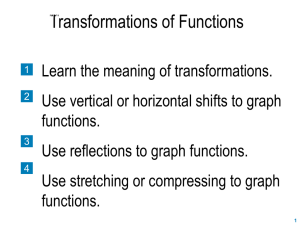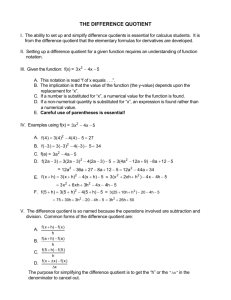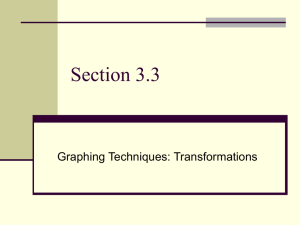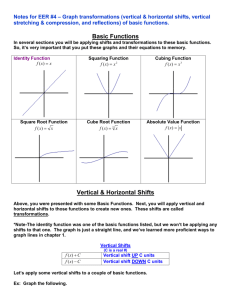CH3 Section 3.2
advertisement
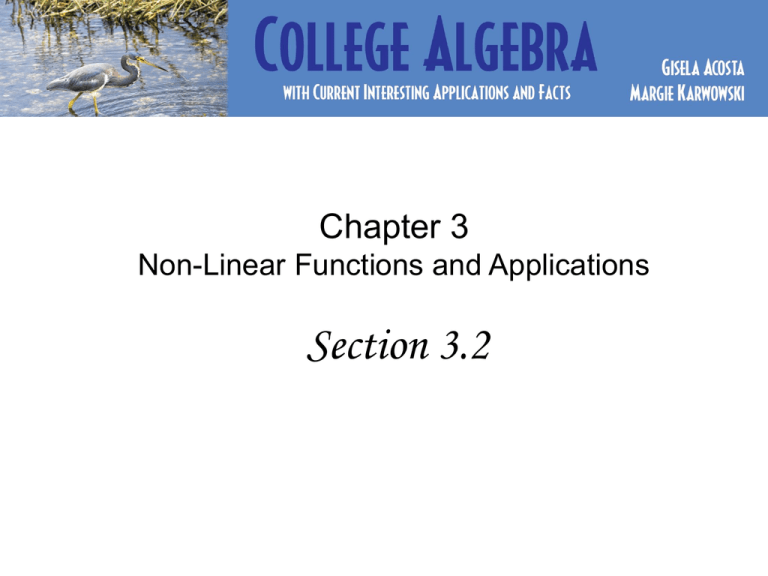
Chapter 3 Non-Linear Functions and Applications Section 3.2 Section 3.2 Transformations • Vertical and Horizontal Shifts • Reflections • Stretching and Compressing Graphs of Functions • Combining Multiple Transformations to Sketch a Graph • Average Rate of Change • The Difference Quotient Review of 7 Basic Functions Square f(x) = x2 Cube Root f(x) = 3 x Cube f(x) = x3 Absolute Value f(x) = x Reciprocal 1 f(x) = x Square Root f(x) = x Identity f(x) = x Vertical Shifts (Up) For a function y = f(x) and c > 0: The graph of y = f(x) + c is equivalent to the graph of f(x) shifted upward c units. Example: f(x) = x2 f(x) = x2 + 4 Vertical Shifts (Down) For a function y = f(x) and c > 0: The graph of y = f(x) – c is equivalent to the graph of f(x) shifted downward c units. Example: f(x) = x2 f(x) = x2 – 4 Horizontal Shifts (left) For a function y = f(x) and c > 0: The graph of y = f(x + c) is equivalent to the graph of f(x) shifted left c units. Example: f(x) = x2 f(x) = (x + 4)2 Horizontal Shifts: If y = f(x + c), why shift left? Examine a table of values for each function: x f(x) = x2 x f(x) = (x + 4)2 –4 16 –3 9 –2 4 –1 1 0 0 1 1 2 4 –4 0 –3 1 –2 4 –1 9 0 16 1 25 2 36 Notice that every point on the graph of f(x) = (x + 4)2 is 4 units to the left of a corresponding point on the graph of f(x) = x2. Horizontal Shifts (right) For a function y = f(x) and c > 0: The graph of y = f(x – c) is equivalent to the graph of f(x) shifted right c units. Example: f(x) = x2 f(x) = (x – 4)2 Horizontal Shifts: If y = f(x – c), why shift right? Examine a table of values for each function: x f(x) = x2 –4 16 x f(x) = (x – 4)2 –4 64 –3 9 –3 49 –2 4 –1 1 0 0 –2 36 –1 25 0 16 1 1 2 4 1 9 2 4 Observe that every point on the graph of f(x) = (x – 4)2 is 4 units to the right of a corresponding point on the graph of f(x) = x2. Summary of Vertical and Horizontal Translations The location of the graph of the function is changed, but the size and shape of the graph is not changed. Vertical shifts: Adding or subtracting “outside” the function Horizontal shifts: Adding or subtracting “inside” the function f(x) + c Shift graph of f(x) upward c units f(x) − c Shift graph of f(x) downward c units f(x + c) Shift graph of f(x) left c units f(x − c) Shift graph of f(x) right c units Vertical and Horizontal Translations Example: f(x) = |x – 2| + 5 inside outside move opposite direction move same direction “2 units right, 5 units up” f(x) = |x| f(x) = |x – 2| + 5 Identify the following graph as a translation of one of the basic functions, and write the equation for the graph. This is the graph of f(x) = x3 shifted left 5 units and down 2 units. f(x) = (x + 5)3 – 2 Reflections about the x-axis The graph of y = –f(x) is obtained by reflecting the graph of y = f(x) with respect to the x-axis. Example: f(x) = x2 f(x) = –x2 Reflections about the y-axis The graph of y = f(–x) is obtained by reflecting the graph of y = f(x) with respect to the y-axis. Example: Given the graph below, (a) state the basic function, (b) describe the transformations applied, and (c) write the equation for the given graph. a. f ( x ) x b. Reflection about the x-axis Horizontal shift: 3 units right Vertical shift: 4 units upward c. f ( x ) x 3 4 Use the corresponding basic function to construct the graph of the function f(x) = (–x)3 – 6. The basic function is f(x) = x3. Transformations in f(x) = (–x)3 – 6: Reflection about the y-axis Vertical shift of 6 units downward Stretching and Compressing Let c be a constant. The graph of y = cf(x) is obtained by vertically stretching or compressing the graph of y = f(x). If |c| > 1, the graph will be vertically stretched by a factor of c. If 0 < |c| < 1, the graph will be vertically compressed by a factor of c. Stretching and Compressing Example: In f(x) = 5x2, stretching “elongates” the graph; the transformed graph appears "narrower" than the graph of f(x) = x2. In f(x) = (1/5)x2, compressing “flattens” the graph; the transformed graph appears "wider" than the graph of f(x) = x2. Combining Multiple Transformations to Sketch a Graph In general, it may be useful to use the following order: 1. Reflection 2. Vertical stretch or compression 3. Horizontal shift 4. Vertical shift Other possible ordering will produce the same result, but do the vertical shift last. Average Rate of Change Let f be a function. Let (x1, f(x1)) and (x2, f(x2)) represent two distinct points on the graph of f, where x1 ≠ x2. The average rate of change of f between x1 and x2 is given by y f ( x 2 ) f ( x1 ) x x 2 x1 Let x represent a test number, and y equal a test score. Assume a student obtains a test 1 score of 76 and a score of 92 on test 3. Find the average rate of change from test 1 to test 3. Given the points (1, 76) and (3, 92) we find the average rate of change by calculating: y f ( x 2 ) f ( x1 ) x x 2 x1 y 92 76 16 8 x 3 1 2 The Difference Quotient Let f be a function and h a nonzero constant. Let (x, f(x)) and (x + h, f(x + h)) represent two distinct points on the graph of f. The average rate of change of f between x and x + h is the difference quotient, given by f (x h) f (x) h Notice that the main operations involved in the "difference quotient" are subtraction (difference) and division (quotient). Find the difference quotient for f(x) = 3x2 – x. Before we apply the formula f(x h) f(x) h it is recommended to first find f(x + h): f(x h) 3(x h)2 (x h) Caution: (x + h)² x² + h² Recall (x + h)² = (x + h)(x + h) = x² + 2xh + h² f(x h) 3(x 2 2xh h2 ) (x h) 3x 2 6xh 3h2 x h (continued on the next slide) f(x h) f(x) Now we find the difference quotient: h (3x 2 6xh 3h2 x h) (3x 2 x) h 3x 2 6xh 3h2 x h 3x 2 x h 6xh 3h2 h h h(6x 3h 1) h 6x 3h 1 Using your textbook, practice the problems assigned by your instructor to review the concepts from Section 3.2.

